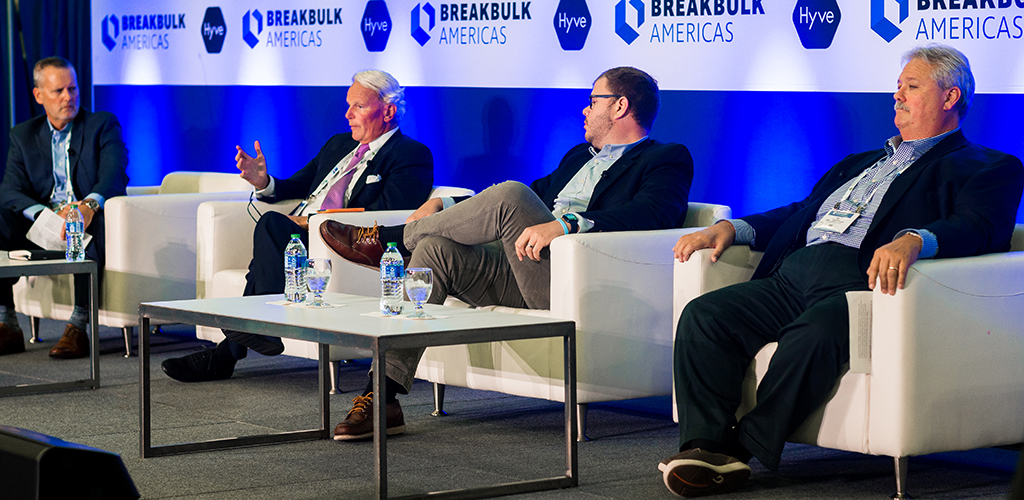Nov 03 | 2021
‘Look at What You Have, Develop What You Need’
 The nascent U.S. offshore wind industry will roll out and function differently than the European model, and its fabrication, supply chain, construction and operational elements will vary substantially depending on which U.S. coast is in play, panelists at a Breakbulk Americas session said.
The nascent U.S. offshore wind industry will roll out and function differently than the European model, and its fabrication, supply chain, construction and operational elements will vary substantially depending on which U.S. coast is in play, panelists at a Breakbulk Americas session said.Walter Cruickshank, deputy director of the U.S. Department of the Interior’s Bureau of Ocean Energy Management, or BOEM, said offshore wind is now a priority. He said 1.8 million acres have already been leased for commercial use, and 16 more final plans are in review. Vineyard Wind’s proposed 800-megawatt project located near Martha’s Vineyard will be the first commercial-scale offshore wind project in the U.S. If approved, South Fork Wind Farm, near Long Island, will be the second.
Cruickshank touted progress toward establishing new wind energy areas on the west coast, building the first Jones Act compliant offshore wind vessels and the first offshore wind substation in Texas, and improving BOEM processes for all. While he acknowledged that there is much to do, he said: “Yes. We are ready for offshore wind in this country and for a cleaner more equitable energy future for this nation.”
Tim Axelsson, director of Liberty Green Offshore, said offshore wind will spur the economy. It will bring “opportunities in supply chain management and logistics … These aren’t one off like oil and gas. These are 100 off.” He said building an efficient supply chain will be critical to industry success, “but first, the permits need to start flowing.”
Edward Anthes-Washburn, Crowley Shipping’s director of business development for offshore services, said the offshore industry will be big but warned of challenges. “There is over US$45 billion of capital expenditure waiting in the wings. Can it make it through the next political cycle? I believe so,” he said, citing demand by Northeast states and a growing number of leases. But, he cautioned, “this is the land of low return. Electrical generation by state-regulated entities is a long term-play, a 10- to 20-year play at least.” That’s important for investment.
On Sept. 30, the day following Anthes-Washburn’s statement, Vineyard Wind announced a partnership with the City of Salem, Massachusetts, and Crowley to transform Salem Harbor into an offshore wind port.
Meeting the federal goal of 30 gigawatts of offshore wind energy by 2030 is a tall order. Simultaneous greenhouse gas reduction goals around the world will lead to a “crunch.” Anthes-Washburn said the shortage of large-scale equipment and assets needed to install offshore wind turbines is global. To build out the wind farms in a timely manner, “Somebody is going to have to build a big-ass crane ship,” Anthes-Washburn said.
Port Guidance
Percy Pyne, chairman and co-founder of Green Shipping Line, provided some guidance to ports and facilities looking for offshore wind-related business. “Stop the happy talk. Look at what you have, develop what we need. Accept the fact that the port is the port,” and pursue opportunities that match strengths. He described multiple supply chain and logistics opportunities, such as fabrication, storage, feedering, operations and maintenance.
Pyne said the U.S. can’t completely emulate the European model, but that it is likely to need foreign jack-up rigs. Jones Act vessels will be used to feeder between ports and wind farms. And while many components like blades and nacelles may continue to be made in Europe, the U.S. will fabricate many components regionally,
Pyne said the U.S. West Coast isn’t far behind the Northeast in development, but its offshore wind industry will look differently. That is largely because floating platform technology, not fixed, will be necessitated by the West Coast’s narrow outer continental shelf.
In the Gulf, with its mature oil and gas supply chain, Pyne said there is potential for leveraging other low-carbon fuels, like green hydrogen. That, coupled with the region’s political environment.
